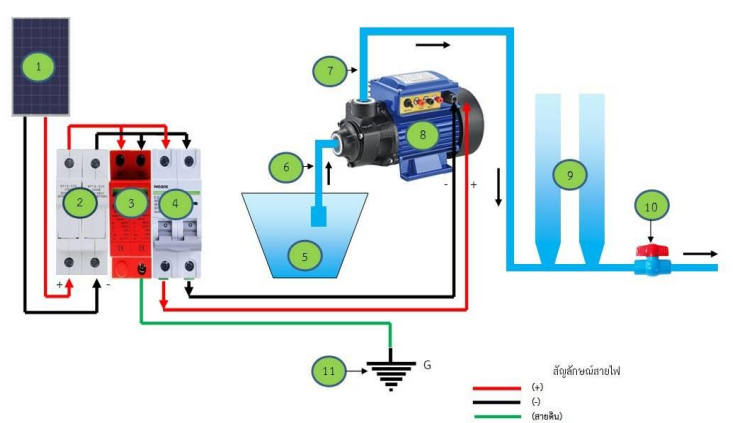THE SOLAR MOBILE PUMPING SYSTEM FOR COMMUNITY FOUNDATIONS HOUSEHOLD LEVEL
Main Article Content
Abstract
The purpose of this research were to study and develop the solar mobile pumping system for the community at the household level and to analyze the amount of water that obtained in each period from the solar mobile pumping system. The main equipment consists of a DC motor pump at 250 watt together with a solar panel at 400 watt, which were installed on a mobile trolley with the dimension of 70 centimeters width, 135 centimeters length and 70 centimeters height. A DC electric fuse, circuit breaker, a DC Surge Protector and a monitor showing the information of the voltage value, electric current, and electric power were installed on the internal control cabinet. The amount of water flow through the pipe of a 3 inch width and 60 centimeter height were also measured. After installing and testing the equipment, the 3 level of inclination (10, 20 and 30 degrees) of the solar cells were examined during 8:00 a.m. to 5:00 p.m. on average 6 times in 1 hour with 3 replications. It was found that the highest efficiency for all 3 levels was at 1:00 p.m. The maximum water volume of each inclination levels were 1411.18, 1,965.74 and 1,624.10 liters per hour, respectively. The suitable inclination level was 20 degrees which obtained the maximum amount of water of 13,848 liters or 13.85 cubic meters per day.
Article Details

This work is licensed under a Creative Commons Attribution-NonCommercial-NoDerivatives 4.0 International License.
เนื้อหาและข่อมูลในบทความที่ลงตีพิมพ์ในวารสารวิชาการ เทคโนโลยี พลังงาน และสิ่งแวดล้อม บัณฑิตวิทยาลัย วิทยาลัยเทคโนโลยีสยาม ถือเป็นข้อคิดเห็นและความรับผิดชอบของผู้เขียนบทความโดยตรง ซึ่งกองบรรณาธิการวารสารไม่จำเป็นต้องเห็นด้วย หรือว่าร่วมรับผิดชอบใด ๆ
บทความ ข้อมูล เนื้อหา รูปภาพ ฯลฯ ที่ได้รับการตีพิมพ์ในวารสารวิชาการ เทคโนโลยี พลังงาน และสิ่งแวดล้อม บัณฑิตวิทยาลัย วิทยาลัยเทคโนโลยีสยาม ถือเป็นลิขสิทธิ์ของวารสารวิชาการ เทคโนโลยี พลังงาน และสิ่งแวดล้อม บัณฑิตวิทยาลัย วิทยาลัยเทคโนโลยีสยาม หากบุคคล หรือหน่วยงานใดต้องการนำทั้งหมด หรือส่วนหนึ่งส่วนใดไปเผยแพร่ต่อ หรือเพื่อกระทำการใด ๆ จะต้องได้รับอนุญาต เป็นลายลักษณ์อักษรจากวารสารวิชาการ เทคโนโลยี พลังงาน และสิ่งแวดล้อม บัณฑิตวิทยาลัย วิทยาลัยเทคโนโลยีสยาม เท่านั้น
References
กรมพลังงานทดแทนและอนุรักษ์พลังงาน. (2563 พฤศจิกายน 25). คู่มือเทคโนโลยีที่เหมาะสมโครงการศึกษาพัฒนาต้นแบบชุมชนพลังงานทดแทน, [ระบบออนไลน์], แหล่งที่มา: https://www.dede.go.th/ewt_dl_link.php?nid=42136
มูลนิธิชัยพัฒนา. (2563 พฤศจิกายน 26). ความหมายของเศรษฐกิจพอเพียง, [ระบบออนไลน์], แหล่งที่มา: https://www.chaipat.or.th/site_content/item/3579-2010-10-08-05-24-39.html
ชวกร รุ่งทวีชัย และอนุรักษ์ ตาคำ. “การติดตั้งปั๊มน้ำโซล่าเซลล์สำหรับการเกษตรเพื่อการพัฒนาที่ยั่งยืน”. ปริญญานิพนธ์ วศ.บ. (วิศวกรรมอุตสาหการ) คณะวิศวกรรมศาสตร์. มหาวิทยาลัยเชียงใหม่, เชียงใหม่, 2562.
นครินทร์ รินผล. “คู่มือการออกแบบระบบไฟฟ้าพลังแสงอาทิตย์เบื้องต้น”. จรัลสนิทวงศ์การพิมพ์, กรุงเทพฯ, 2559.
แฟ็คโตมาร์ท. (2564 พฤศจิกายน 6). ประเภทของ Flow Meter, [ระบบออนไลน์), แหล่งที่มา: https://mall.factomart.com/type-of-flow-meter
การไฟฟ้าส่วนภูมิภาค. (20 กรกฎาคม 2564). อัตราค่าไฟฟ้า-การไฟฟ้าส่วนภูมิภาค, [ระบบออนไลน์], แหล่งที่มา: https://www.pea.co.th/Portals/0/demand_response/Electricity%20Reconsider.pdf?ver=2018-10-01-155123-370.
วิศวกรรมสถานแห่งประเทศไทย ในพระบรมราชูปถัมภ์. “มาตรฐานการติดตั้งทางไฟฟ้าสำหรับประเทศไทย: ระบบการผลิตไฟฟ้าจากพลังงานแสงอาทิตย์ที่ติดตั้งบนหลังคา”. พิมพ์ครั้งที่ 2. จุฬาลงกรณ์หาวิทยาลัย, กรุงเทพฯ, 2561.
จารุวรรณ พิพัฒน์พุทธพันธ์. (2564 พฤศจิกายน 4). ตำแหน่งของทิศที่ควรติดตั้งแผงโซล่าเซลล์, แหล่งที่มา: https://www.dede.go.th/ewt_dl_link.php?nid=55175
ศรายุทธ์ จิตรพัฒนากุล กฤษณะ จันทสิทธิ์ และธีรวัฒน์ ชื่นอัศดงคต. “ระบบปั๊มลมพลังงานแสงอาทิตย์สำหรับอุตสาหกรรมขนาดเล็ก”. วารสารวิจัยรำไพรรณี, 14(2), 2563, 43-54.
ทวีศักดิ์ ทองแสน ชัยวัฒน์ เย็นศิริ และสิวา สมอแข็ง. “เครื่องสูบน้ำด้วยพลังงานแสงอาทิตย์”. รายงานการวิจัย. มหาวิทยาลัยมหาสารคาม, มหาสารคาม, 2560.


